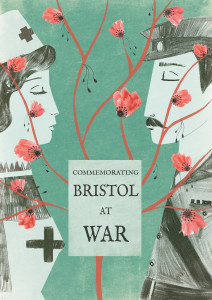‘That vile place’ Stanley Spencer RA, a medical orderly in Bristol

Share this
After the War I can see myself doing some strange things. It will be something like this:- I arrive home, two days after get in a train for Bristol, get out at Bath, stand on the Railway platform & look towards a certain loathsome suburban church standing in the side of big hill. Take notes & get back into train. Get out at Bristol, on tram up to Fishponds. Go up a certain hill, a slummy street on left; small cottage, window-sill, on the windowsill earthenware animals & flower pots, on the other side of house small cottage garden on a steep slope, on opposite slope little orchard. Take notes and return to Cookham. [1]
It’s not quite clear why the artist Stanley Spencer took such an exception to the inoffensive church overlooking the railway station in Bath Spa: perhaps it reminded him of his grim experience at another ‘loathsome’ building on the north-east shoulder of Bristol – the military hospital known during the war as ‘the Beaufort’.
The vast hospital complex on the edge of Fishponds is hewn from the same uncharitable rock that built the Muller Orphanages in nearby Ashley Down. Formerly the Bristol Lunatic Asylum, the Beaufort was converted in 1915 to accommodate the vast numbers of wounded not just from the Western Front, but from far away as Gallipoli. Stanley Spencer’s brother Gilbert, also a medical orderly recalled having to dress bandages fro hard-bitten wounded Australians, the Turkish mud still stuck to their boots.
Beyond the rather severe appearance of the building and its austere interiors, the gardens and courtyards whose orchard trees and tidy flowerbeds were meticulously maintained by inmates of the asylum.
Three months were spent converting the asylum to house up to 1,460 wounded soldiers. Day rooms and night wards were converted into medical and surgical wards. Corridors were refurbished to cope with emergency admissions. Even the maximum-restraint cells were requisitioned for temporary use. Throughout the asylum, rooms were provisionally adapted to act as operating theatres, radiography departments and pharmacy stations. Photographs show the hospital retained some of its pre-war character: wards are strewn with large potted plants and ornate furnishings, though little could disguise the hard deal tables, the flagstone floors and the high windows with their cast-iron glazing bars. Glimpsed in one of these photographs is the young English painter Stanley Spencer: a diminutive, slightly disheveled figure in an ill-fitting tunic, surrounded by long avenues of beds, each separated by large, ungainly wooden lockers.
Stanley Spencer was to become one of Britain’s greatest twentieth century artists; famous perhaps for two things: his celebration and immortalisation of his home town of Cookham – his ‘heaven on earth’ as he lovingly called it, and the fusion in his paintings of sex and religion, love and dirt, the heavenly and the ordinary.
Spencer’s visionary imagination was realised through many hundreds of paintings, drawings and thousands of letters, some of them a hundred pages long written both to the living and to the deceased. They exposed a complex understanding of his world and his ability to transform the menial and the banal into intense images of joyous delight. Through hundred of paintings Spencer transformed Cookham into a visionary paradise where his family and neighbours would daily rub shoulders with Old Testament figures; and where it seemed entirely appropriate that Christ would wander in the garden behind the local schoolyard.
But possibly Spencer’s greatest single creation is not of Cookham, but of the Beaufort hospital in Bristol and a battlefield in the Balkans. He translated his war experience into an extraordinary series of murals on the painted walls of the Sandham Memorial Chapel in Hampshire (owned by the National Trust since 1947). It is perhaps the most complete memorial to peace and redemption ever completed in the aftermath of the First World War. There is nothing like it anywhere in Europe.
In 1915 Spencer left home to serve as a medical orderly in the medical corps. Aged 24, and a little over five feet tall and not even seven stone in weight, he had rarely stayed away overnight from home. Arriving in Bristol, straw boater on his head, Gladstone bag in hand, he was terrified of the hospital and its rough camaraderie. For ten months he did little more than scrub floors, bandage convalescent soldiers and cart supplies around the vast lunatic asylum-cum-hospital. A resilient and courageous young man, Spencer was shocked by the carbolic grimness of the hospital, but he noted everything around him storing everything for future reference:
I had to scrub out the Asylum Church. It was a splendid test of my feelings about this war. But I still feel the necessity of this war, & I have seen some sights, but not what one might expect. The lunatics are good workers & one persists in saluting us & always with the wrong hand. Another one thinks he is an electric battery… [2]
It was during that loathed, yet strangely fulfilling, act of scrubbing floors that he met Desmond Macready Chute, an individual who would have a quite unique impact on the young painter. Described by Stanley as ‘brilliantly clever, and with all that spiritual outlook and vision and mystery looked and longed for,’ (117) Desmond came from an extraordinary family in the history of Bristol. Indeed, his very birth had been heralded by the Bristol Evening News as an event of ‘dynastic proportions’. His widowed mother, Abigail, was one of the city’s most well known characters and a prominent hostess in fashionable and artistic circles. Second daughter of Joseph Hennessy, a prominent Bristol Liberal and successful businessman in the cattle trade, she was married in 1886 to James Macready Chute whose family had dominated Bristol’s theatre for several generations. James owned the Prince’s Theatre in Bristol and was also director of the Prince of Wales Theatre in Birmingham and the Gaiety Theatre in Dublin. Following his sudden death in 1912 – when Desmond was seventeen – these responsibilities fell to Abigail, whose energetic and dominating manner extended to the influence over her son, as much as it did to her lavish soirées that attracted such celebrities of the day as Henry Irving, Ellen Terry, Mrs Patrick Campbell and Sarah Bernhardt.
Over six feet tall, with reddish-brown hair, slim and good-looking (and in all these attributes so very different from Stanley) Desmond was a devout Roman Catholic, later to become a priest, who had begun studying at the Slade School of Art in 1913 but at the outbreak of war had discontinued his studies. Extremely widely read, highly capable and sensitive to the point of being withdrawn and reserved, Spencer thought him ‘nervous & generally not suited to ‘Society’ with large round eyes that are very searching, contemplative, severe, gentle and charitable, in the one & only sense of the word’. Chute had been made head of school at St Gregory’s, Downside before his short-lived sojourn at the Slade. Returning to Bristol at the outbreak of war, and excused military service because of his delicate health, he proved to be of little use in promoting his family’s theatrical interests.
Stanley spent much of his 36-hour leave each month wandering around Clifton with Chute; the two locked deep in conversation, or at his family’s large Edwardian home in Clifton. They attended musical and artistic visits to the Clifton Arts Club. Socially exuberant in sympathetic company, Stanley thrived in the artistic set of Clifton and Desmond found in Stanley an ideal pupil, thirsty for literary and musical enrichment. Stanley, four years older than Desmond, felt fulfilled and less exercised by his menial labour at the Beaufort. Chute had introduced him to the Confessions of St Augustine’s, who had stated that:
There is a glorifying God, in all His different performances. This struck me very much …’ Ever busy, yet ever at rest. Gathering yet never needing, bearing, filling, guarding, creating, nourishing, perfecting, seeking though thou hast no lack! ‘ And so I thought ‘bearing, filling,’ coming, going, fetching, carrying, sorting, opening doors, shutting them, carrying tea-urns, scrubbing floors, etc. Yes, [Desmond] was a friend indeed. I never disliked doing any of these things; … sweeping up had become part of the performance of painting the picture afterwards.
In 1916 he escaped the menial drudgery of the hospital, signing up for overseas duty on the malarial battlefields of Macedonia where he saw violent action up until the eve of the Armistice.
Five years later Spencer started making large drawings of a possible memorial scheme based on his wartime experiences. So extraordinary were his sketches, and so committed was he to realizing them in paint, that two patrons funded a purpose-built memorial chapel at Burghclere, a few miles south of Newbury. It was to be dedicated to Henry Willoughby Sandham, a young officer who had died in 1919 from illness contracted on the fated Macedonian campaign.
For five years, between 1927 and 1932, Spencer toiled, often on top of a giant scaffold, to produce the painted chapel that is now regarded as his masterpiece. Unflinching in its detail, celebratory in its love for the common man, and joyous in its celebration of earthly redemption, the chapel is one of the unsung artistic glories of Britain. The vast end wall, some twenty feet high, describes the resurrection of the soldiers as they calmly emerge from the sodden earth and return their white crosses to the workmanlike figure of Christ who can be spotted high on the wall wandering between lazing mules and coils of barbed wire. A lower ‘predella’ panel relates the benighted narrative of ‘Stanley the medical orderly’; a unique visual record of the menial life of the bearer, an invisible cadre who often found themselves reduced to ‘one-third housemaid, one-third waiter and one-third valet’.
The Oratory tells both Spencer’s personal story as ‘orderly, soldier, and patient’ and perhaps also a parable of ‘innocence, fall and redemption.’ Stanley, though, would have laughed at such grand aims. His spirituality was always well grounded. As he explained to his future wife in 1932:
Everything I did meant a spiritual revelation to me. Everything I had to do became a key to my conception of spiritual life. Just cutting up bread and butter in the kitchen in the [hospital] ward revealed to me as much of the spiritual life I longed to attain to, as if I had sat down and had half an hour’s talk with God.
The success of the memorial chapel was both a blessing and a curse for Spencer; his highly personal and often ‘difficult’ narrative paintings of the Thirties found little favour amongst many critics and buyers who felt his wayward genius needed the grand unifying challenge of a project like the chapel’s walls. Spencer felt it too and for decades he would carry the weight of Beaufort, Bristol and the Balkans long after he had left Burghclere.
Notes
[1] Stanley Spencer to his sister Florence Image, 27th June 1918, TGA, 756.4 (the typescript of these letters is Tate Gallery Archive, TGA 733.1.753).
[2] Stanley to Gwen Raverat, July/August 1915, TGA 8116.54
The chapel of Beaufort War Hospital is now home to Glenside Hospital Museum where you can see the exhibition Postcards from a War Hospital (to 13 December 2014).
The Sandham Memorial Chapel at Burghclere is now run by the National Trust.
This article is an extended version of the essay which is included in ‘Four Artists’ in Bristol and the First World War, the book distributed as part of the Great Reading Adventure.

